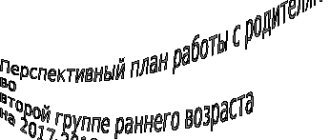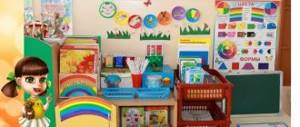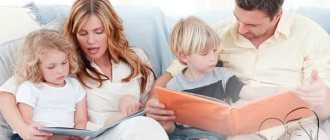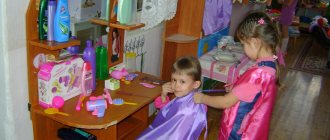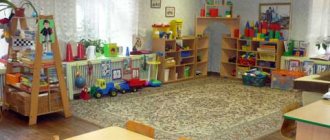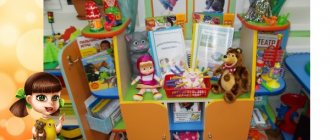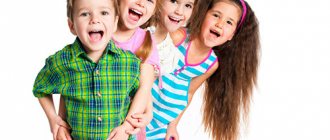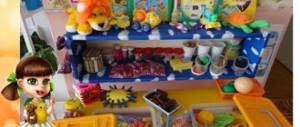Where should you start?
The use of a developmental environment is directly related to its organization. The task of the preschool educational institution staff is to take care of the main centers (or corners) in the kindergarten group, focused on the development of a particular skill. Several subject centers will help you improve, develop, and polish your speech. More on them a little later.
For a methodologist who will draw up methodological recommendations, it is important to understand two things: what to write and how to write. How to write, that is, the structure of recommendations, can be seen in other similar documents. I have selected a small list of references that you can refer to. And additionally extract useful information from these manuals. So, publications on the topic:
- A manual on planning and monitoring the subject-spatial environment for senior educators.
- A publication with notes and presentations on creating a developmental environment according to the Federal State Educational Standard. Includes both book and CD.
- Another guide to creating a developmental environment. This time only the disk .
- The subject-spatial environment must not only be created and developed. We need to monitor her condition. An assessment and control journal in the form of a paper book and a program for installation on a PC .
- A couple of useful offline webinars. The first is to build a developmental environment in an early age group. And here is another version of the same webinar. The second is more specialized and concerns specifically the speech environment in preschool educational institutions.
- And another webinar . He will tell you how to systematize the environment in accordance with the age of kindergarteners.
- Advanced training course on designing a subject-spatial developmental environment in preschool educational institutions . There is an option to start in August. And there is the same one that starts in September .
- Professional retraining course . Concerns issues of subject-spatial and inclusive environment.
Which centers in the group should be used for speech development?
Speech is one of the important mental functions. It allows you to transfer information. The child must acquire speech skills in preschool age. They are not given at birth, and speech has to be taught. This applies to all children without exception. Few people perceive speech by ear and independently. In most cases, it takes a lot of effort to teach speaking skills on time. This is a concern for both preschool teachers and parents.
A developing subject-spatial environment is an organized space with selected materials and equipment. It helps teach a child a variety of age-appropriate skills. Here it is written in detail about the requirements for a development environment.
A subject-spatial environment conducive to speech is formed in the premises of the preschool educational institution group. It consists of several centers (corners, or stands). For children of different ages, the list of stands may be almost the same, but their content will differ. The following centers will help you work with speech:
- speech and book;
- game;
- theatrical;
- art center;
- sensory-constructive;
- others (indirectly).
There are certain requirements for the developing subject-spatial environment in kindergarten. According to the Federal State Educational Standard, it should be easily transformable, rich in content, multifunctional, accessible, safe, aesthetically attractive, and psychologically comfortable. And quickly transform into a conventional space for the current game: a clinic, a cafe, a clearing in the forest.
An organized subject-speech environment should help resolve the following issues:
- develop vocabulary;
- work on grammatical structure (teach word formation and correct grammatical structures);
- develop coherent speech (learn to retell, describe, guess riddles);
- to form a full-fledged sound culture of speech (improve breathing, improve auditory attention and clarity of sound pronunciation);
- develop fine motor functions.
The group environment should be age appropriate. And allow the alternation of different activities: educational, social and independent. A rich and appropriate developmental environment will be exciting for the child. It will improve speech and diversify the development of the baby.
Subject-based developmental environment in early age groups - presentation
Modern approaches to the formation of a subject-based developmental environment in preschool institutions The direction of a child’s activity and development largely depends on us, adults - on how the subject-spatial organization of their life is structured, what toys and teaching aids it consists of, what their developmental potential is, and even on how they are located. Everything that surrounds a child shapes his psyche and is the source of his knowledge and social experience. Therefore, it is we, teachers, who take upon ourselves the responsibility to create conditions that would contribute to the most complete realization of children’s development in all psychophysiological parameters, i.e. organization of the subject-spatial environment.
The developing environment is a unity of social and natural factors that can influence directly or indirectly, instantly or long-term on the life of a child (i.e., the social culture of society, in fact, this is the world into which a child comes when he is born). A developing subject environment is a system of material objects of a child’s activity, which in turn models the content of the child’s spiritual and physical development. Thus, the subject-spatial environment is an integral part of the developmental environment of preschool childhood.
Particular importance in preschool institutions is attached to an object-based play environment, since the main activity of the child is play and its influence on the comprehensive development of the individual cannot be overestimated. The concept of “subject-game environment” is a component of the “developing subject environment”.
Objectives of the development environment Protection and strengthening of the physical and mental health of children, their physical development; Protection and strengthening of the physical and mental health of children, their physical development; Emotional well-being of each child; Emotional well-being of each child; Intellectual development; Intellectual development; Creating conditions for personal development; Creating conditions for personal development; Introducing children to universal human values; Introducing children to universal human values; Interaction with the family in order to optimize the educational process. Interaction with the family in order to optimize the educational process.
Components of the development environment Social component Mutual understanding and satisfaction of all subjects with relationships. Spatial-subject component Integrated environment for the comprehensive development of the child Psychodidactic component Pedagogical support for the child’s developmental capabilities
Basic principles of building a developmental environment 1. The principle of positional distance during interaction - focused on organizing a space for communication between an adult and a child 2. The principle of activity - this is the possibility of joint participation of an adult and a child in creating the environment 3. The principle of stability - dynamism - focused on creating conditions for change according to taste, mood and possibilities. 4. The principle of integration and flexible zoning - realizes the possibility of constructing non-overlapping spheres of activity and allows children to simultaneously engage in different types of activities without interfering with each other. 5. The principle of combining conventional and extraordinary elements is the aesthetic organization of the environment. 6. The principle of “gender and age” differences realizes the opportunity for girls and boys to express their inclinations in accordance with the norms accepted in our society 7. The principle of freedom for a child to achieve his right to play. 8. The subject-spatial environment should be oriented toward the zone of “proximal development.”
For young children, the main directions of development are: changing the leading motives of activity; development of emotional, business and substantive communication; development and activation of general movements; development of objective actions and objective activities; development of visual and effective thinking; intensive accumulation of passive vocabulary, stimulation of active speech; mastering various skills in the process of imitation; formation of self-image; formation of prerequisites for constructive and visual activities; activation of independence in everyday life and the formation of the need for recognition of one’s own achievements; strengthening self-care skills; development of inner speech.
4 main types of child activities: play; productive; cognitive and research; motor.
Developmental environment of early age groups in kindergarten 5. Nursery. The didactic table in early age groups is indispensable. In one place, various kinds of toys and materials are concentrated, different in the direction of development of the child’s actions.
Multifunctional aid - airplane Used as play equipment for plot-based games, as well as an original and convenient shelf for placing aids.
Constructive activity corner The variety of construction sets and their convenient placement makes this area very attractive for children.
Rational placement of toys allows the child to freely choose those that are interesting to the baby at a given time. It is very important to take into account the variety of toys, their texture, size, and purpose.
We play with dolls. In this play area, a child learns the basics of adult life. The more material there is to play out, the more independent life situations that are simulated. How interesting it is for a child to play the role of an adult. This gives him confidence and teaches him how to live as an adult.
Young children love all toys that rattle, ring, and make noise. This is sometimes inconvenient for adults, but nevertheless, all these noisy toys develop the baby. Therefore, it is necessary in an early age group to find a place to place children’s musical instruments. It would not be superfluous to create a mini-dressing room, or a dressing room. This will not only add originality to the educational process, but will also allow the small child to independently resolve some issues.
Artistic and speech zone The book corner is adjacent to the “noise” toys corner. The filling of the book corner is diversified by the introduction of various types of theaters. It’s great when the group has and uses a music center. Creative activity begins at an early age. Music and literature contribute to the development of creative abilities.
Motor activity corner Mobiles and machines not only help organize plot-based play, but also serve as an additional means of stimulating movements at an early age. The use of massage mats and non-standard sports equipment creates interest in physical education.
First junior group In this group, many mini-zones are compactly assembled on a large and spacious shelf. Some of them require children to directly contact the teacher.
Musical instruments, theatrical figures, and visual aids form the creative activity of a 3-year-old child.
Corner of sensory development Benefits for every taste - pyramids, inserts, sleeves, button holders, lacing. All this develops manual skills and contributes to enriching sensory experience.
Physical activity corner Sports equipment should be located within the child’s reach. In this case, bright, light baskets containing balls, ring throws, and pins were chosen very well. Multifunctional mats made by teachers are indispensable for massaging the feet.
Artistic and speech zone A relaxation corner where you can sit quietly and leaf through an interesting book, which the teacher will kindly serve at the child’s request.
Next to the book corner there is a zone of cognitive activity - a corner of board and printed games. It’s nice to sit at a table covered with a beautiful tablecloth in comfortable chairs and solve tasks offered by board games. Books that contain tasks for the development of mental processes, as well as games, contribute to the development of the child’s cognitive sphere.
"Doll's room" Living room. Kitchen.
In the doll corner there is a manual for the game “hairdresser”. In this case, it is presented both in this capacity and as a dressing area. The versatility of this manual allows it to be used in different areas.
Developmental environment of early age groups in school 1. (state farm) The color scheme, brightness of colors, and wall decoration are also part of the child’s developmental environment, as they affect the comprehensive development of the baby through sensory education and the formation of aesthetic taste.
The use of textile materials in the design of a group not only performs the function of separating play areas, but also creates coziness in the room, creating a homely atmosphere.
Motor activity corner Filling the corner with toys - engines, a multi-colored slide, gurneys, non-standard equipment stimulates the child's motor activity; competent guidance from the teacher will allow targeted and effective action on all muscle groups.
“Sensory” corner Didactic aids located in this play area correspond to the age characteristics of children. Their diversity stimulates the child’s cognition and forms the concept of sensory standards. Sensory play is extremely important at an early age, as sensory development is the foundation of mental development.
Multifunctionality of benefits What is it? There are many answers. This is a big plus. This corner allows you to diversify the child’s role-playing game.
Multifaceted corner This corner combines different types of activities - from cognitive-experimental to artistic-creative. Such proximity does not interfere with the child’s choice of activities according to his interests.
Game corner
The play corner consists of several parts: kitchen, dining room, room, bedroom. Strollers, playpen and other toys are included.
Developmental environment of an early age group in school 1. Nursery. Rational placement of games and aids allows the teacher to diversify the actions of children with objects
Pyramids, lacing, and various construction sets help solve the problems of both sensory education of children and the development of fine motor skills.
A doll corner, decorated in the same style, cultivates aesthetic feelings, and also contains the entire complex of children's play furniture.
A theatrical area for games in early age groups stimulates the development of a child’s speech and has a beneficial effect on the formation of the emotional sphere.
A variety of benefits for the physical education of children.
Soft pillows of different shapes and colors encourage your baby to relax and create a cozy atmosphere. A house for privacy with windows and doors, just like a real one. This is where there is scope for the development of display play.
A large selection of toys has a positive effect on the mental development of children. A book corner located at the height of the child allows you to easily select the book you like.
The theoretical basis for organizing a subject-developmental spatial environment for young children was the research of T. N. Doronova, N. A. Korotkova, N. M. Aksarina, as well as regulatory documents of SanPiN. A skillfully organized environment reduces conflict in children’s communication with each other by more than 50%, and relieves anxiety in the absence of a close adult. Children adapt faster to a group of peers. They become interested in kindergarten and want to be with their peers
This presentation is the work experience of teachers of early age groups: Dvornikova V.L. Gnevysheva V.A. Belovol A.S. Makarova N.V. Kryzhopolskaya N.N. Uglanovoy P.Yu. The manual is recommended for preschool teachers. This presentation is the work experience of teachers of early age groups: Dvornikova V.L. Gnevysheva V.A. Belovol A.S. Makarova N.V. Kryzhopolskaya N.N. Uglanovoy P.Yu. The manual is recommended for preschool teachers. Compiled by: Dvornikova V.L. – head of the Ministry of Defense
The speech center is one of the main ones for the development of speech
Most often, the speech development corner is combined with the book corner. The tasks for both are similar. They form a vocabulary, learn to listen, describe objects and phenomena.
The content of the thematic rack of these two centers can be as follows:
- Books – fiction and educational.
- Didactic games for speech development.
- Sets of plot, subject and thematic pictures.
- Various games and lotto.
A literary center for the little ones can contain only 4-5 books on cardboard or a thick base. Volume – up to 5 pages. We need to prepare a few more replacement books. Editions with moving eyes, windows, etc. would be very appropriate. A good option would be transformable books, folding ones, panoramas with moving figures, etc. Publications with animal voices will also come in handy.
Now - in more detail about filling the speech center for the first junior group. Try using these elements:
- Sets of thematic pictures or postcards (4-6 pieces each) on the theme of domestic and wild animals, birds, fish, trees, flowers, fruits and vegetables, food, transport, furniture, dishes, clothing.
- Pictures for grouping according to a specific criterion.
- Pictures (3-4 pieces each) to create a sequence (plot of a fairy tale, story).
- Pictures 4 pcs. for times of day and seasons.
- Large, colorful pictures on social everyday life or fairy tale themes - something that will be interesting to the child.
- Lotto with images of birds and pets.
- Various games and aids that form correct breathing (“Butterflies”, “Leaves”, tubes, light snowflakes made of paper, etc., where you need to use a stream of air).
- Aids and toys for the development of phonemic awareness (rattles, noise instruments, music boxes).
- Aids for articulation exercises, including wall and individual mirrors.
The speech development center must have sufficient space. So that children alternately study while sitting on the carpet, at tables, or move according to the rules of the games. Equipment for story-based didactic games can be stored not only on stands. But also in baskets or boxes. It is worth putting the appropriate pictures on them so that the children themselves can get what they need.
Developmental gaming environment in an early age group according to the Federal State Educational Standard
Organization of a developing gaming environment in the context of the requirements of the Federal State Educational Standard for preschool education (from work experience)
The innovative nature of the Federal State Educational Standard of preschool education is expressed in such concepts as socialization, individualization of development and support for children's initiative.
These are three core tasks, around the solution of which the content of modern preschool education is built [1, p.4]. When organizing a developmental play environment in our group, where young children go, we took into account the Federal State Educational Standard for Educational Education and were guided by provisions that describe the situation of child development, including three groups of conditions: - spatiotemporal (play space, toys, furniture), - social ( system of relationships with peers and adults), - activity (motor, play, communicative, visual activities, construction, perception of fiction and folklore). According to the Federal State Educational Standard for Educational Education, a developmental environment is a certain ordered educational space in which learning takes place [1, p. 5]. Properly organized, it helps an adult ensure the harmonious development of the child, create an emotionally positive atmosphere in the group, organize and conduct games and activities, and thus teach children to play independently. Our group has created conditions for the development and learning of young children. When selecting toys, we took into account pedagogical expediency, artistic acceptability, age interests of children, gender specificity, safety, hygiene, etc. Games and toys available in a group in sufficient quantities give children the opportunity to demonstrate small physical activity in the group, carry out object-based and play activities , development of fine motor skills against the background of the emotional component of interaction with adults and peers. Although in this article we have conditionally divided the didactic materials used in working with children into separate centers, in pedagogical practice we use the same material to solve different educational problems, thereby observing the principle of variability, integration and complementarity. We pay great attention to the development of motor activity, so we divided the center of motor activity into two parts. In one part there are large sports modules, such as a slide and a dry pool, and in the other part there is a “health track”, including massage mats. At the center of motor activity there are balls of different sizes, skittles, dumbbells, flags, rings with multi-colored ribbons, and hoops. There are technical toys: train, truck, dump truck; a car, rocking toys, cars that children can ride on their own. The nature of the object and play environment is associated with color, shape, size, orientation in space, etc. Therefore, the group contains pyramids, rods for stringing with colored elements of various shapes, a large floor pyramid, nesting dolls, sets of cubes and volumetric bodies, toys-tools ( scoops, spatulas with sets of molds, fishing rods, nets, scoops, rakes, hammers, etc.), sets of volumetric inserts, mosaics, insert frames, puzzles, construction sets. For experimentation, there is a special table with a tray, floating and sinking objects, plastic materials (clay), and tubes for inserting objects. The toys available in the group are made from materials of different qualities and different densities. To create an emotional component of interaction with adults and peers, there are toys with secrets and surprises, toys with light effects, a “magic bag,” soap bubbles, wind-up toys, fun toys, glove puppets, masks, etc. In the speech development center there are sets of subject and plot pictures on various topics. For visual reference, the group has a “carousel” on which pictures are hung. These pictures change once a quarter: according to the season and theme (toys, transport, Christmas decorations, etc.). In order for the child to have privacy, there is a doll corner in the group with stationary and tabletop doll furniture, tabletop “kitchen” sets, character toys, dolls of different sizes in clothes, naked dolls, anthropomorphic animals, etc. The mummers' corner is designed in the form of a hut, where there is a mirror and a chest with doll clothes. Multi-colored skirts, vests, scarves, shirts, and handbags hang on hangers. To develop children's hearing, in the music corner there are toy musical instruments (tambourines, drums, rattles, maracas, spoons, bells, pipes, metallophones), sound books, musical toys, audio equipment (tape recorder, audio materials with recordings of musical works). The theater center is represented by sets of dolls, fairy-tale characters, screens for puppet performances, costumes, masks, etc. There is a magnetic board, different types of theater (bibabo, tabletop, finger), and audio equipment. The group has an art center and a book corner. All of the listed games and aids are placed on shelves that are fixed at the height of children and are available for use. Thus, when organizing a developmental gaming environment, we put the tasks of the psychological and emotional well-being of children, providing opportunities for communication, joint activities of adults and children, and physical activity at the forefront. We believe that the educational gaming environment in our group meets the requirements of the Federal State Educational Standard for Education. Literature: 1. Sleptsova, I. Features of the organization of a developmental gaming environment in the context of the requirements of the Federal State Educational Standard for preschool education / I. Sleptsova // Preschool education. – 2017. – No. 2. – P.4-8.
We recommend watching:
Summary of entertaining activities in kindergarten. Junior group Planned results of mastering the program in the junior group according to the Federal State Educational Standards Features of the development of children of primary preschool age Age characteristics of children 3-4 years old according to the Federal State Educational Standard briefly
Similar articles:
Organization of a walk in the junior group according to the Federal State Educational Standard
Observations of wildlife in the younger group of kindergarten
Observations of inanimate nature on a walk in the younger group
Observations of the work of adults in the younger group
Observations of street life. Junior group
